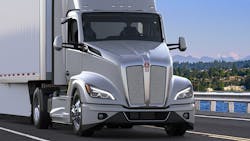Paccar’s Feight expects stronger Class 8 truck demand in 2026 amid policy clarity
Key takeaways
- Paccar forecasts Class 8 sales between 230K and 270K in 2026, signaling possible market recovery if freight and policy stabilize.
- Regulatory clarity on EPA27 emissions could shape prebuy activity and impact fleet replacement decisions.
- Aging equipment and replacement cycles may boost truck demand, supporting stronger pricing next year.
The market for heavy-duty trucks in the U.S. and Canada could take a solid step forward in 2026 if policy uncertainty clears up and the freight market begins to show some improvement, Paccar CEO Preston Feight said this week.
Speaking after Paccar, the parent of truck makers Kenworth and Peterbilt, reported third-quarter results on October 21, Feight told analysts that his team is forecasting Class 8 sales of between 230,000 and 270,000 units next year. The floor of that range is the same as this year’s Paccar forecast—which has come down substantially from late-2024 projections—but the top end is 10% higher than the 245,000 that marks the high end of the company’s latest forecast this year.
On a conference call, Feight said his team is looking forward to regulatory clarity “when it happens” on emissions rules, specifically the Environmental Protection Agency’s call for all heavy-duty trucks to emit no more than 35 milligrams of nitrogen oxides starting with the 2027 model year.
“There’s some uncertainty in how quick the truckload sector recovers,” Feight said in discussing EPA27 and other variables steering Paccar’s 2026 forecast. “Is it sometime in the first quarter [or will it] take a little bit? I think we also are anticipating that the 35-milligram law is what’s going to be there. If it changes, that would obviously take away some prebuy.”
Feight’s guarded optimism about tariffs and broader policy stability comes near the end of a year in which the country’s largest fleets have pulled back spending on equipment in the face of economic and regulatory uncertainty, as well as an ongoing weak freight market. ACT Research said earlier this month that Class 8 orders in September were down more than 40% year over year, while medium-duty classes saw orders fall 22%.
The assessment of 2026’s potential from Feight also is more upbeat than that of one of his peers: AB Volvo President and CEO Martin Lundstedt said October 17 after his team reported the company’s third-quarter results that his team has lowered its 2025 forecast for North America—which for Volvo’s purposes includes Mexico—by 10,000 units to 265,000 and that it expects sales next year to slide to 250,000 trucks.
“That is, of course, subject to a high level of uncertainty, given that there are quite a number of parameters in flux as we speak,” Lundstedt added.
Paccar’s Q3 numbers and ’26 pricing hopes
Paccar produced a third-quarter net profit of $590 million on sales of $6.1 billion. In the same period of last year, those numbers were $972 million and $7.7 billion, respectively. The company delivered a total of 31,900 trucks during the quarter, 17,100 of them to customers in the U.S. and Canada—which was down from 25,900. Feight and his team expect Q4 deliveries to be in line with Q3.
Looking beyond that, Feight thinks Paccar will have opportunities to raise some of its prices as the market strengthens next year. Many customers, he said, have been running their equipment and getting closer to having to make new buying decisions.
“The LTL market […] remains good, the vocational market remains good. And then I think the truckload sector has been in a tough spot for, gosh, 30 months-plus,” he said. “As they get back under replacement cycles, it’s going to create demand in the market, which is obviously good for pricing.”
About the Author
Geert De Lombaerde
Senior Editor
A native of Belgium, Geert De Lombaerde has more than two decades of experience in business journalism. Since 2021, he has written about markets and economic trends for Endeavor Business Media publications FleetOwner, Healthcare Innovation, IndustryWeek, Oil & Gas Journal, and T&D World.
With a degree in journalism from the University of Missouri, he began his reporting career at the Business Courier in Cincinnati. He later was managing editor and editor of the Nashville Business Journal. Most recently, he oversaw the online and print products of the Nashville Post and reported primarily on Middle Tennessee’s finance sector and many of its publicly traded companies.



